Understanding the Confidential Name Change Process in Sacramento
The law provides confidentiality for a petitioner seeking a name change who is a participant in the Secretary of State’s confidential address program, Safe at Home, under California Government Code §6205 et seq., and who asserts reasons for a name change that include:
- Seeking to avoid domestic violence
- Seeking to avoid stalking
- Filing as, or on behalf of, a victim of sexual assault.
One of these reasons must be stated in the papers files with the Petition for Change of Name. If you do not qualify for a confidential name change, use our guide Understanding the Name Change Process in Sacramento.
Before You File in Court
Enroll in the Secretary of State’s Safe at Home program. Then, submit an “Intent to Change Name” form (provided by the Safe at Home program) listing your desired new name. Safe at Home will issue you “Court Letters” authorizing the change. You must include these when filing in court. This must be done before filing in court.
If you are requesting a name change because of a reason or circumstance listed in California Code of Civil Procedure (CCP) § 1277 (b)(2), and are enrolled in the Safe at Home program, you can apply for a confidential name change. Your court documents will not show the new name, to protect you from discovery.
However, the case itself can be found by searching your old name. If your stalker or abuser finds it, they will know that you changed your name (but not your new name) and that you live in Sacramento County. If you believe this will help them find you, you can ask that your entire case be “under seal,” or hidden. You will need to file extra documents explaining exactly why a public record will put you in extra danger.
If you request to file under seal, and the judge refuses, the court will send the papers back without starting a case, and you can choose whether to file a standard confidential name change instead.
Step-by-Step Instructions
1
Become a Participant in the Safe At Home Program
Before requesting a confidential name change, you must first register with the California Safe at Home program by applying to an enrolling agency. The Safe at Home program provides anonymous mailing addresses to people escaping the circumstance listed in CCP § 1277 (b)(2), as well as reproductive health care workers and public health officials.
You can find a local enrolling agency listing by calling the Safe at Home program directly at (877) 322-5227 or checking the Secretary of State’s Safe at Home website.
2
Request and File a Notice of Intent of Name Change with Safe at Home
Obtain, complete and file a Confidential Intent of Name Change (CINC) form with the Safe at Home program. This form lists both the old and new name of the participant and is kept confidential at the Secretary of State’s office.
You must contact Safe at Home (877-322-5227) to request this form. It is not available on the internet and the Law Library does not have them.
Once you file the Notice of Intent of Name Change with the Safe at Home program, the program will send you “Court Letters” verifying that you did so. These must be turned in to the court with your name change forms. They inform the court that the Safe at Home program has authorized the confidential name change.
3
Decide Whether to File Under Seal
Every confidential name change protects your new name from public disclosure. But in some cases, just knowing that you changed your name and that you lived in Sacramento can help your abuser search for you.
If so, you can ask the judge for permission to file under seal. If the judge approves, the entire case will be confidential, meaning the public cannot locate your name change at all.
In the U.S., court records are supposed to be public. So if you want your court records sealed, you must file an extra set of documents requesting permission. You must convince the judge that the threat to your safety is so grave that it outweighs the importance of keeping records open to the public.
This can slow the process down, especially if the judge refuses permission. If that happens, the court clerk sends back all the paperwork back to you, so you can decide whether you want to file the name change petition anyway. (It still will not list your new name).
4
Prepare Your Confidential Name Change Petition Forms
Once you receive the letter from the Secretary of State confirming participation in the Safe at Home program, you can complete and file the required court forms.
4a. Prepare the forms
In Sacramento, download the Petition for Change of Name Under the Address Confidentiality Program (Safe at Home) Packet. This packet includes the standard name change forms as well as the extra paperwork to request to file under seal.
If you would like to request a new birth certificate and that your old birth certificate be sealed, you will also need Attachment (MC-025).
When you fill the forms out, use your current name and your Safe at Home address. If you have used more than one name in the past, include them as “aka” in any line asking for “previous name” (example: Jane Jones aka Jane Smith).
In all spaces asking for the proposed (new) name, you will instead write:
“Confidential on file with the Secretary of State’s Office per provisions of the Safe at Home Program pursuant to the provisions of the Address Confidentiality Program (Code of Civil Procedure Section 1277 (b)).”
Confidential Cover Sheet (NC-400) must be attached as the first page of every other document, to shield it and indicate to the filing clerk that it contains confidential information.
If you decide to request to file under seal, you will need to file three additional extra forms: NC-410 (Application to File Documents Under Seal in Name Change Proceeding); NC-420 (Declaration in Support of Application to File Documents under Seal in Name Change Proceeding); and NC-425 (Order on Application to File Documents under Seal in Name Change Proceeding).
Samples of all of these filled-out forms are attached to this guide.
4b. Assemble Documents for Filing
Make two copies of each court form (You will file three of each paper — the original and two copies). For Items 3 – 9, a Confidential Cover Sheet form (NC-400) must be attached as the first page of each and every copy of each and every document. It can help sort the pages to put a sticky note with the form number on each stack of documents.
Assemble your paperwork in the following order:
- Court Letter from Safe At Home: 1 copy
- Copy of Safe at Home card: 1 copy
- Civil Case Cover Sheet form (CM-010): original +2 copies
- Petition for Change of Name form (NC-100) and the Attachment to Petition for Change of Name form (NC-110) (and Attachment MC-025, if needed): original +2 copies
- Order to Show Cause for Change of Name form (NC-120): original +2 copies
- Decree Changing Name form (NC-130): original +2 copies

4c. Additional Steps when Filing Under Seal
Place Items 3 – 6 in a sealed envelope, with a completed Confidential Cover Sheet (formNC-400) on top marked “Conditionally Under Seal.”
Assemble the remaining documents:
- Application to File Documents Under Seal in Name Change Proceeding Under Address Confidentiality Program (Safe at Home) form (NC-410): original +2 copies
- Declaration in Support of Application to File Documents Under Seal in Name Change Proceeding Under Address Confidentiality Program (Safe at Home) form (NC-420): original +2 copies
- Order on Application to File Documents under Seal in Name Change Proceeding (NC-425):original +2 copies

5
File Your Court Forms
All completed documents should be submitted to the Hall of Justice Building, 813 Sixth St., Sacramento CA 95814, in Room 212 or the drop box in the lobby.
Tip: Unlike most name changes, you do NOT have to publish the Order to Show Cause in a newspaper.
6
Wait to Receive Approval or Denial of Permission to File Under Seal, if Requested
If you have requested to file under seal, the first decision the judge makes is whether to approve that request.
If refused: All paperwork will be returned to you, unfiled. You can then decide wither to re-file with a non-sealed application.
If you did not request to file under seal, or if the judge approves: The court clerk will assign you a hearing date (about six weeks from filing), write it on the Order to Show Cause (NC-120), and return one copy of your paperwork to you by mail.
7
Checking the Judge’s Decision: Tentative Rulings and Hearing
TENTATIVE RULING: Checking the decision online the day before the hearing.
If you filed under seal: You cannot check online. You will get the Decree in the mail a few days after your hearing date.
If you did not file under seal, you can find out what the judge plans to decide (the “tentative ruling”) after 2 p.m. on the day before your hearing date. Log on to the court’s Case Information Portal Page to find the decision.
If the name change is tentatively denied, and you wish to try to change the judge’s mind, you must call the department by 4 p.m. the day before the hearing. Leave a message saying you want to appear. If you do not, the hearing will be cancelled and the Decree will be mailed to you.
On the hearing date, the judge will sign the Decree Changing Name (NC-130) granting or denying your name change. You will receive this order in the mail a few days later.
8
Send the Court Decree to the Safe at Home Program
If your name change is granted, send a certified copy of your court order to the Safe at Home program. Once the Safe at Home office receives it, they will create a new name certificate for you and send it back.
9
Update Records
Use the Decree and the new name certification from Safe at Home to change your name with Social Security, the DMV, and other required agencies.
If you need a new Social Security number, that is a separate process. Read “New Numbers for Victims of Domestic Violence” for information about doing that.
Contact the agency in question to request special forms or procedures to keep the record change from being public. Here are some helpful links for doing that:
- Update your Social Security information. Visit the Social Security Administration website for information.
- After you receive the updated Social Security card, contact the Department of Motor Vehicles Confidential Record Suppression Unit at (916) 657-7142 to learn how to update your records safely.
- If you were born in California, you may request to have your birth records amended through the Department of Public Health – Vital Records Office. For more information, please contact Vital Records at (916) 445-8494. If you were born in another state or country, you must inquire with that state or country’s Vital Records office about their procedure.
- Update educational or professional licenses or public records as necessary.
Note that if you update a public record, such as a professional license or real estate title, it may create a public link between your new identity and your old name.
For Help
SH@LL (Self-Help at the Law Library)
609 9th Street, Sacramento CA 95814
(916) 476-2731 (Appointment Request Line)
Services Provided: SH@LL provides general information and basic assistance to self-represented litigants on a variety of legal issues. All assistance is provided by telephone. Visit “What we can help with” for a list of qualifying cases.
Eligibility: Must be a Sacramento County resident or have a qualifying case in the Sacramento County Superior Court.
For More Information
On the Web
California Secretary of State – Safe at Home Program
Provides information about the program, including how to find an enrolling agency.
Community Resources
Safe at Home Enrolling Agencies /(877) 322-5227
These agencies are identified by the Secretary of State’s office as enrolling agencies for the Safe at Home Program and offer a variety of services to assist domestic violence survivors.
When this was written, the Sacramento area enrolling agencies included:
- Lao Family Community Development, Inc.. (916) 393-7501 or (916) 359-2788
- Opening Doors, Inc., (916) 492-2591
- Sacramento Regional Family Justice Center, (916) 875-4673
- Women Escaping a Violent Environment, Inc. (WEAVE), (916) 448-2321
For up-to-date listings and agencies in other counties, check the Secretary of State’s Safe at Home
website.
Samples
Confidential Cover Sheet (NC-400)
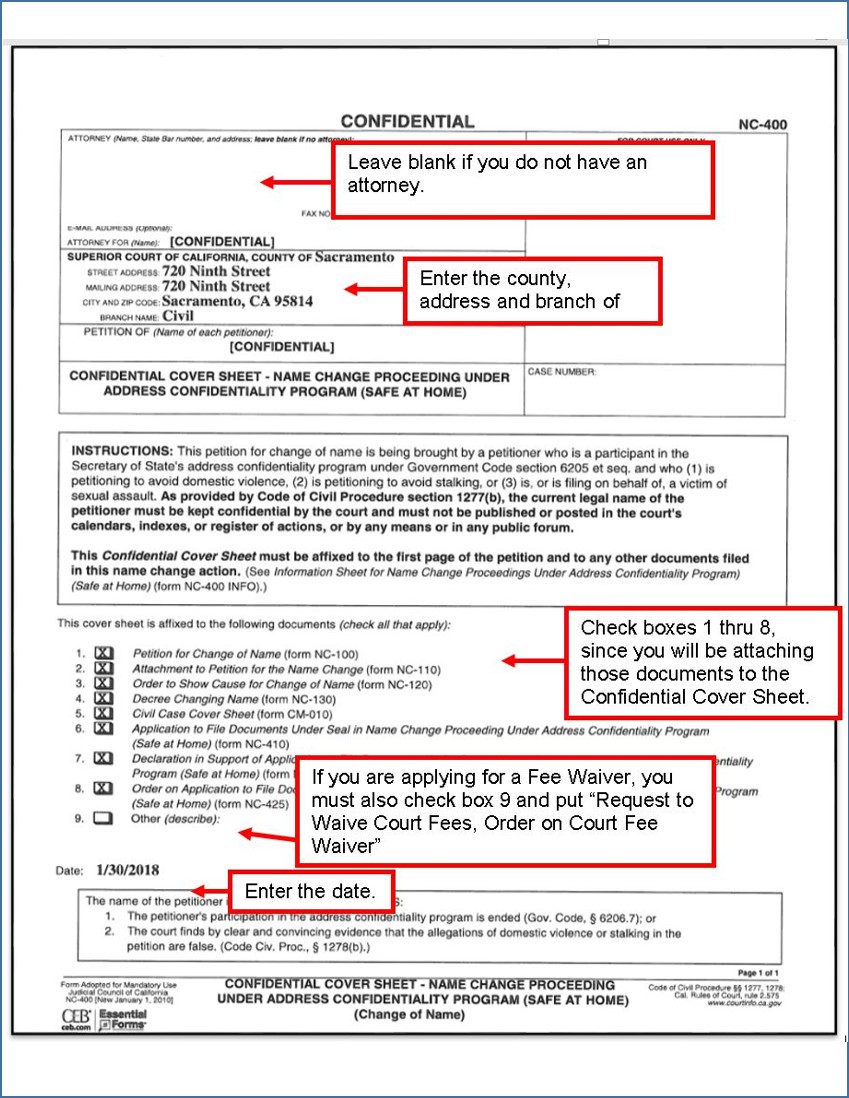
Civil Case Cover Sheet (CM-010)
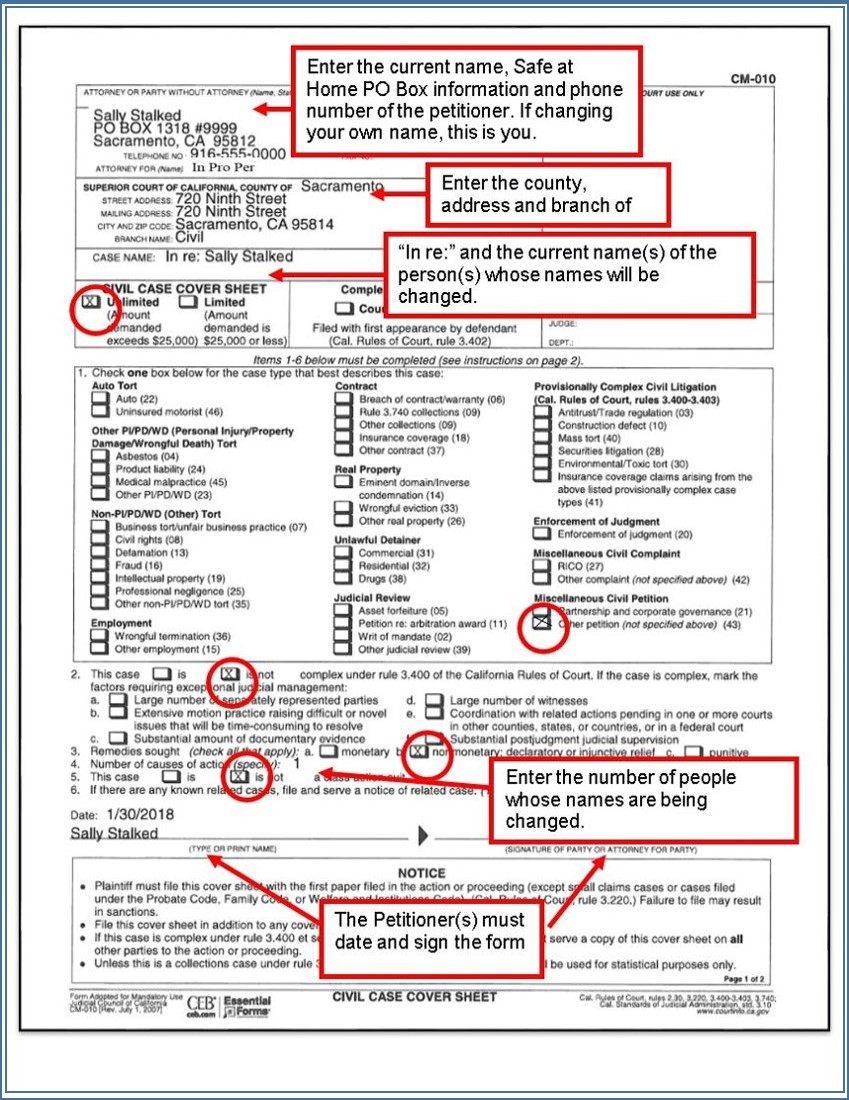
Petition for Name Change (NC-100)
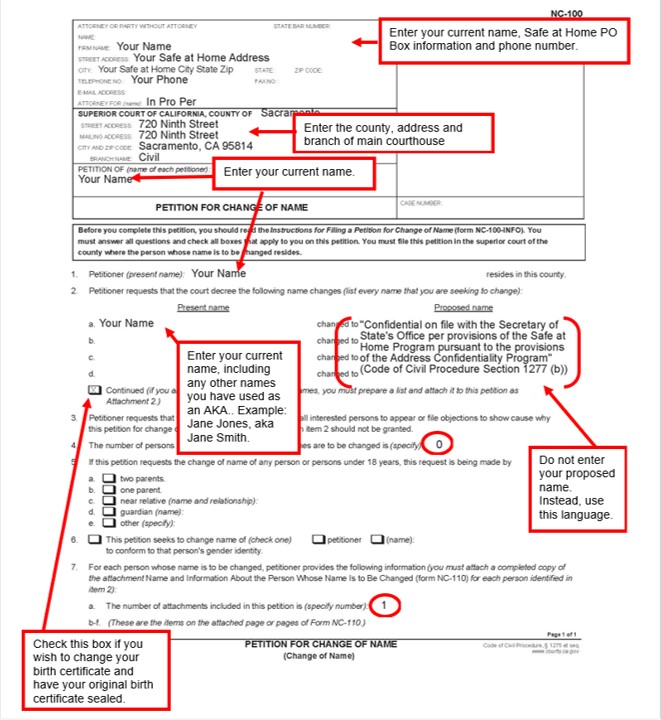
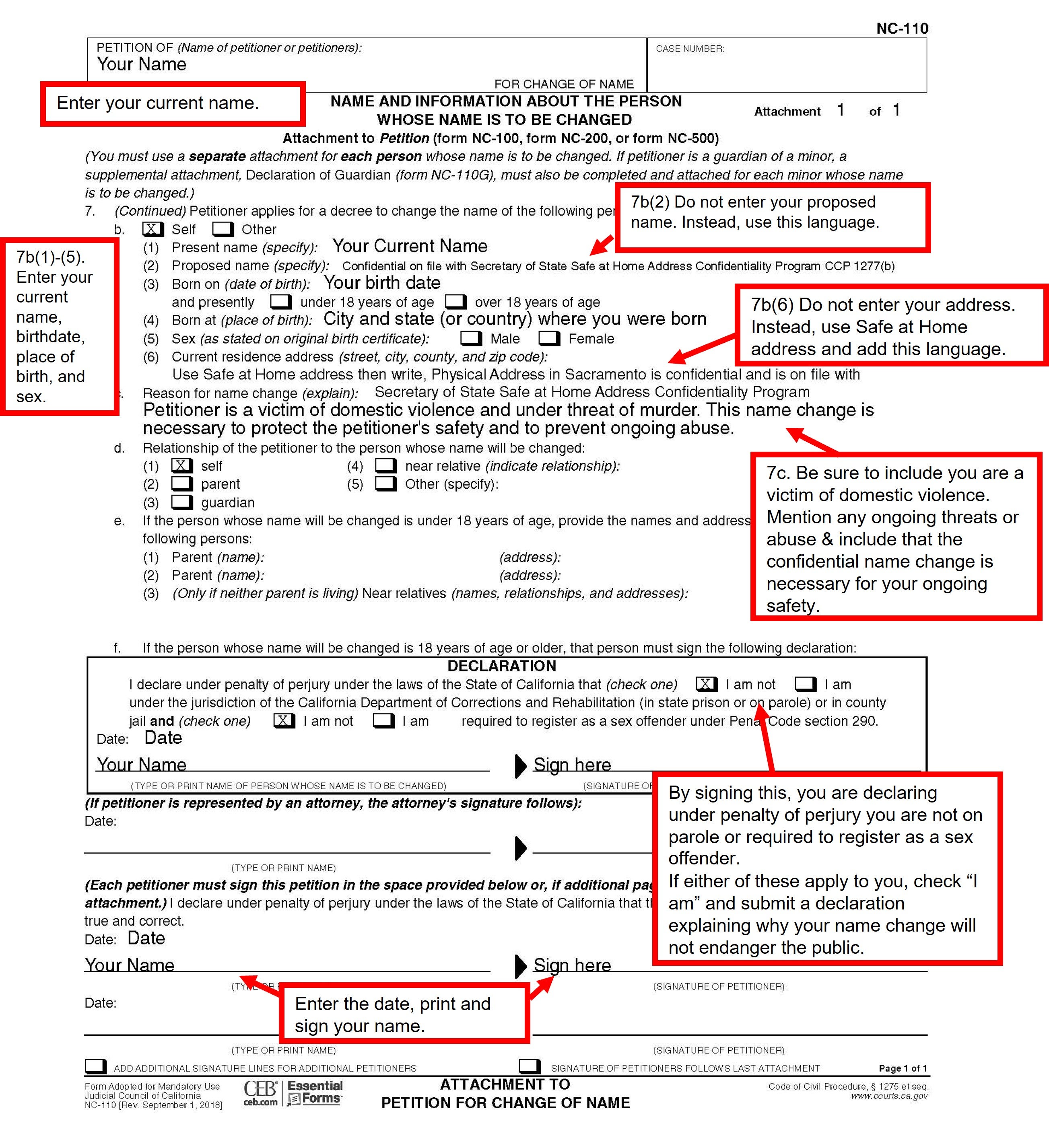
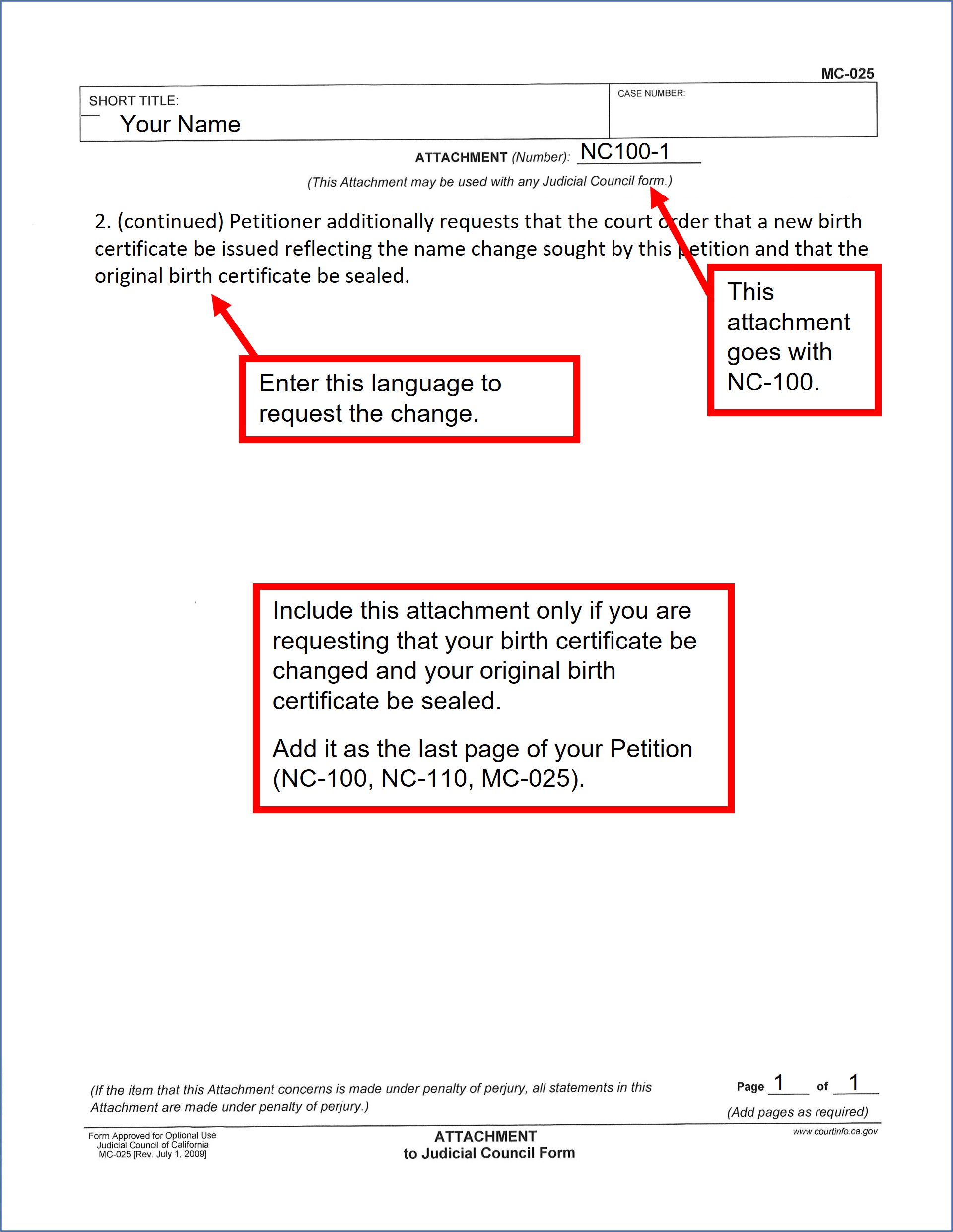
Order to Show Cause (NC-120)
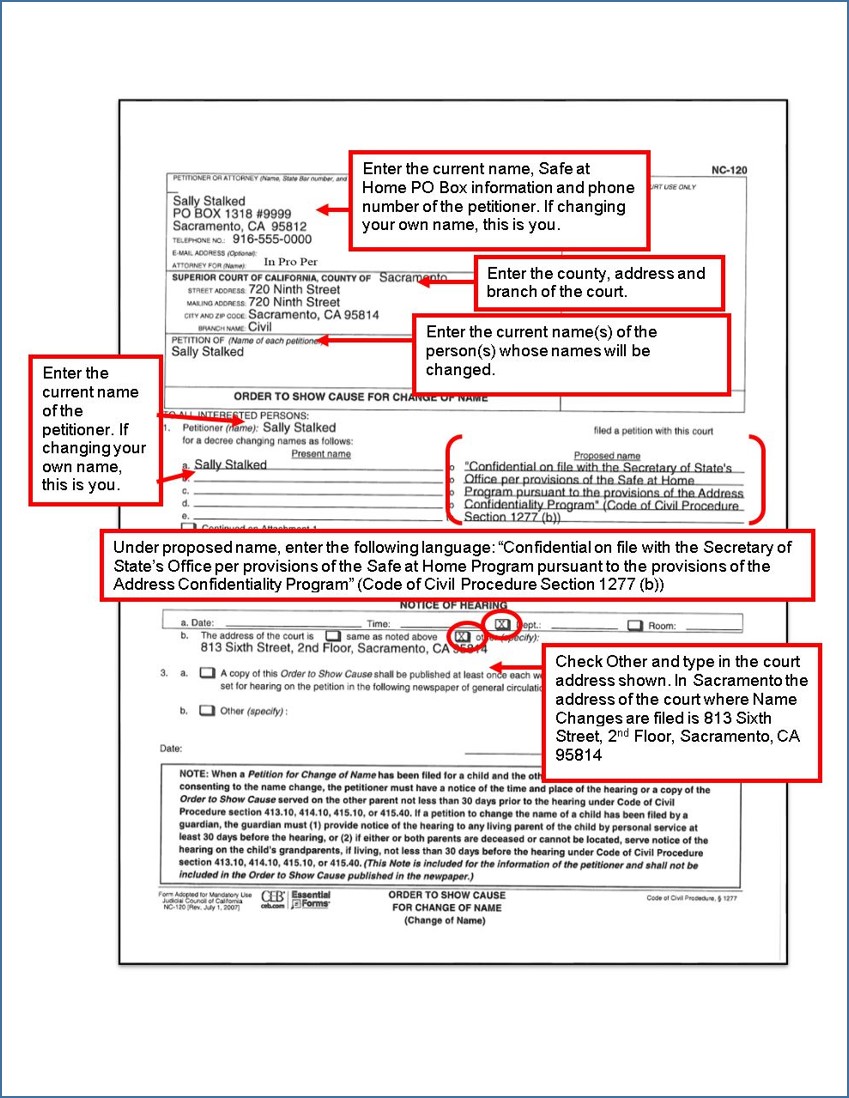
Decree Changing Name (NC-130)
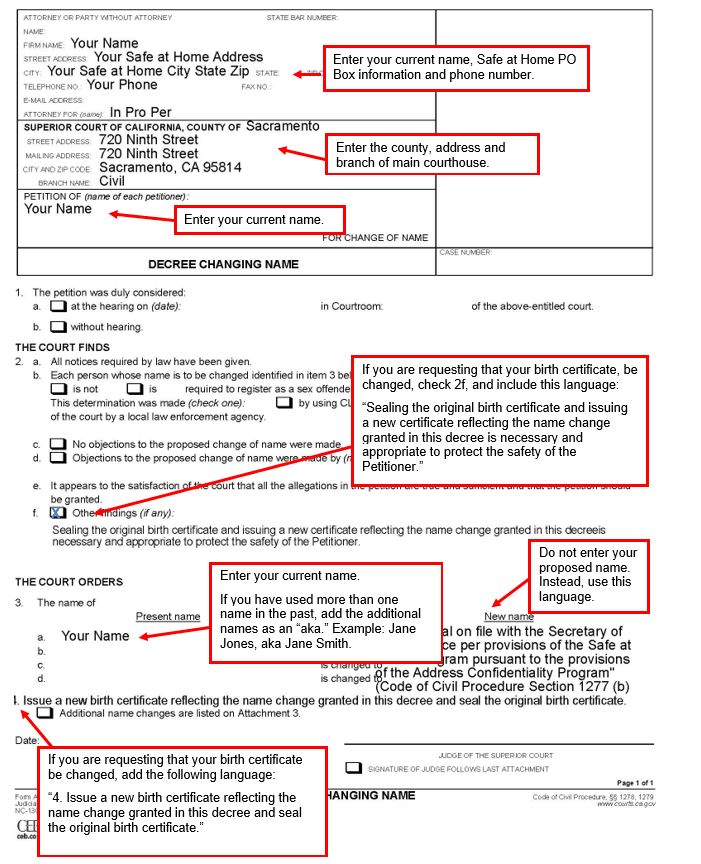
Application to File under Seal (NC-410)
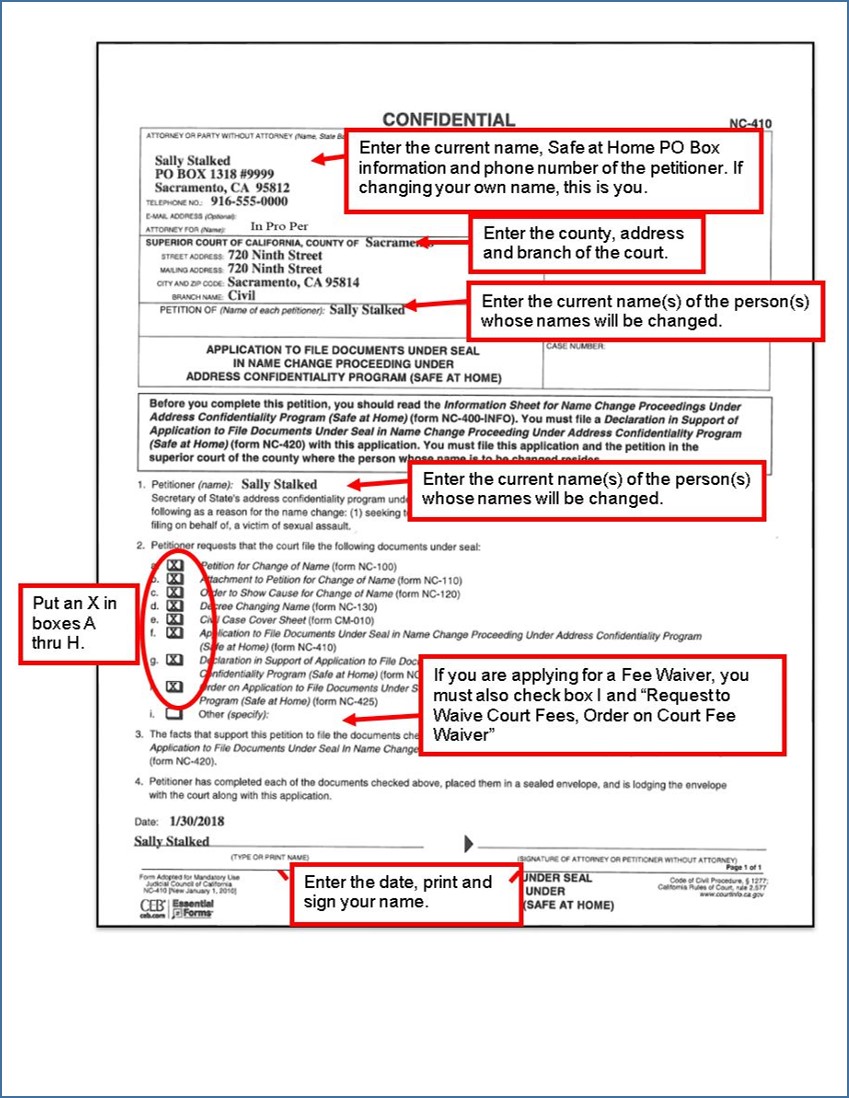
Declaration in Support of Application (NC-420)
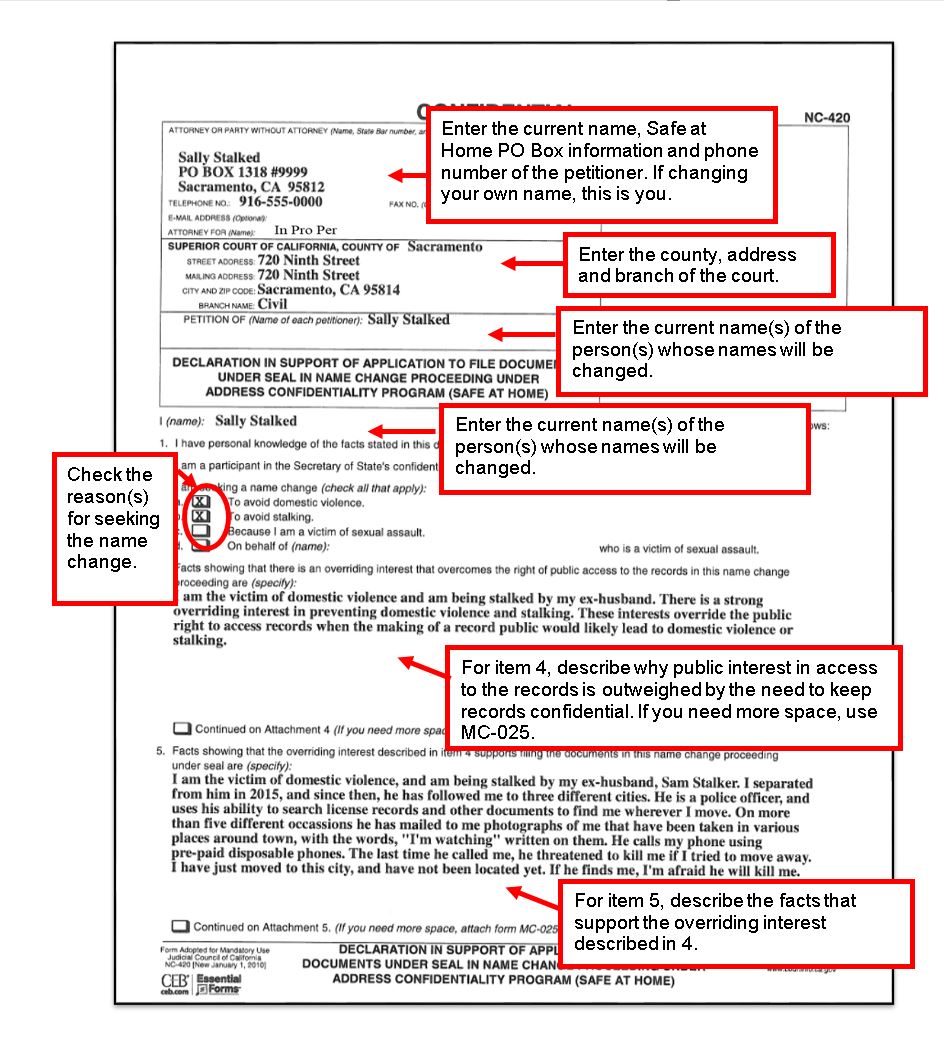
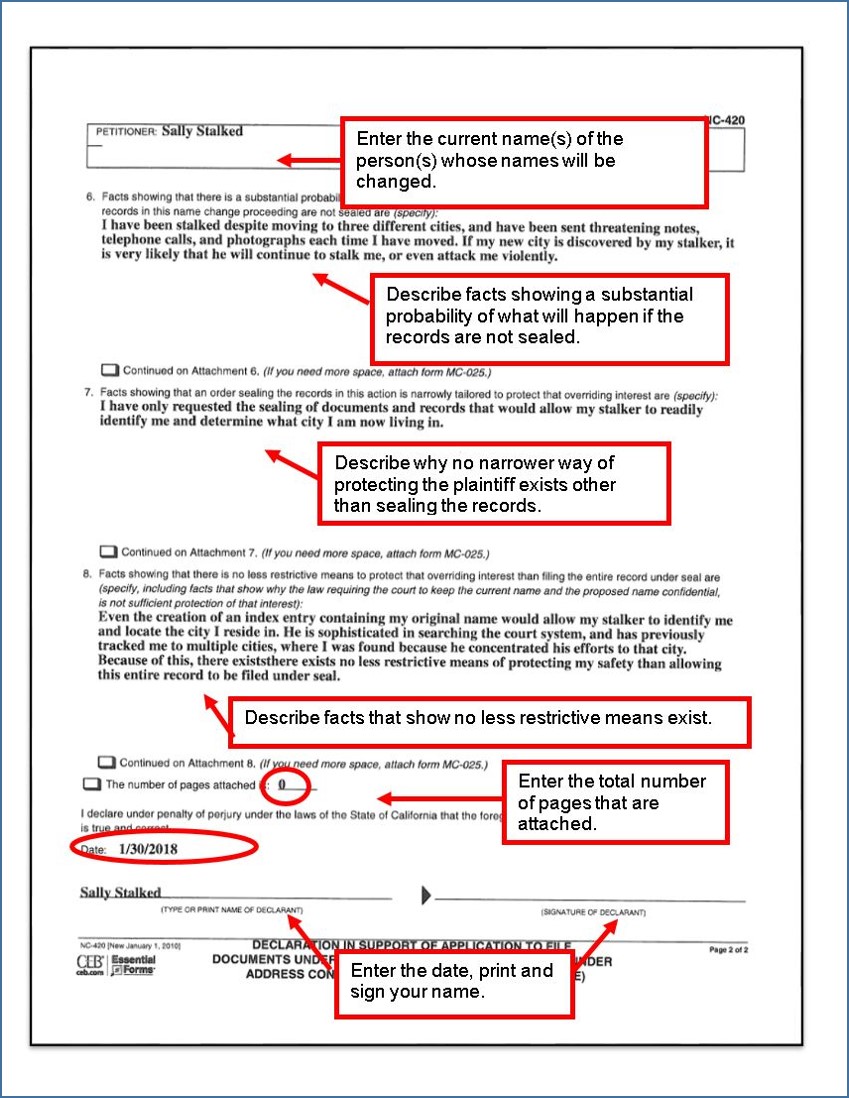
Order on Application to File under Seal (NC-425)
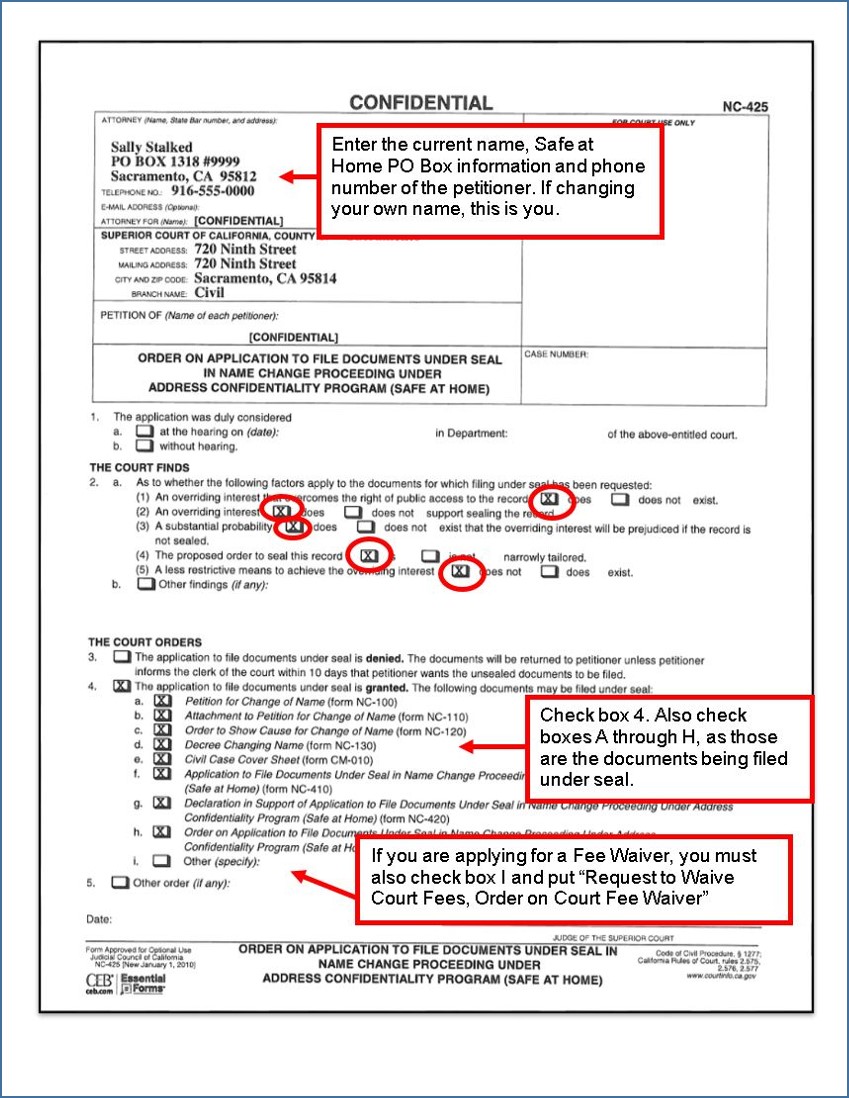
This material is intended as general information only. Your case may have factors requiring different procedures or forms. The information and instructions are provided for use in the Sacramento County Superior Court. Please keep in mind that each court may have different requirements. If you need further assistance consult a lawyer.




